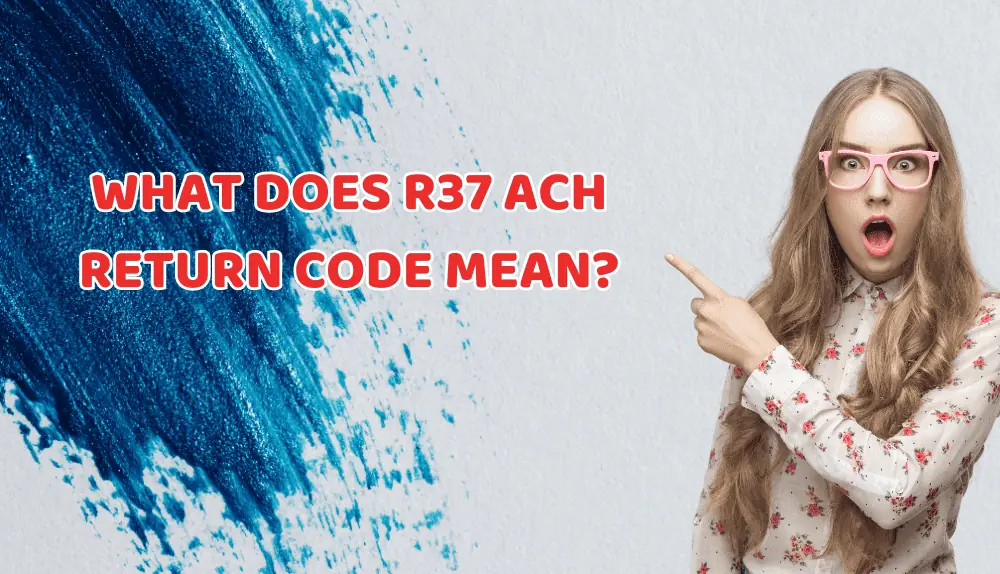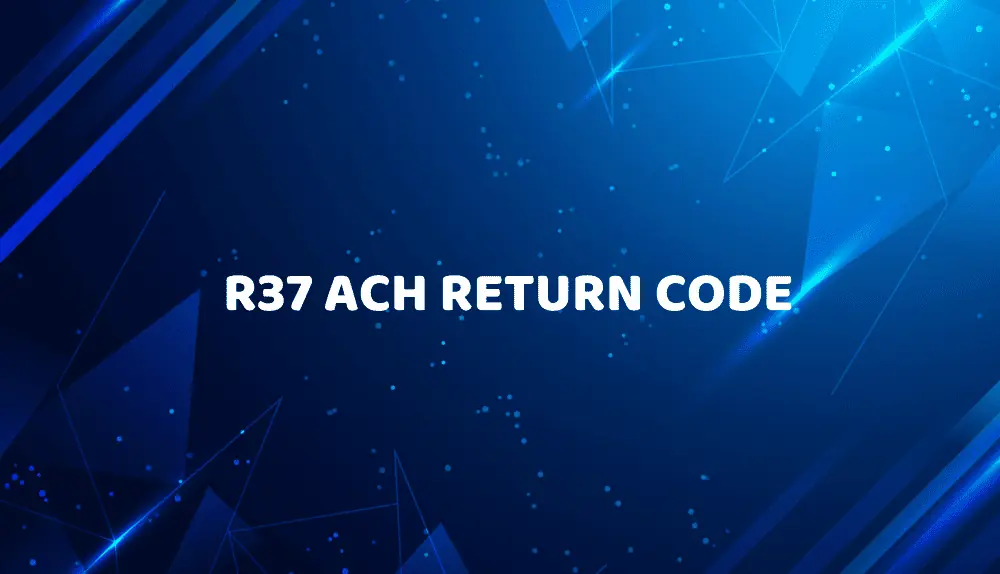R37 ACH return code is an important code for source document presented. This article will explain the ACH R37 return code , why it occurs and other details.
What Does R37 ACH Return Code Mean?

The ACH R37 Return Code signifies a critical aspect of the Automated Clearing House (ACH) system, serving as a crucial safeguard in electronic payment transactions. When this code is encountered, it indicates that a particular ACH entry has been returned due to “Source Document Presented,” implying that the payment was initiated based on a check that was previously presented to the bank.
Essentially, the R37 code acts as a shield against the duplication of payments, preventing instances where a physical check and its electronic ACH counterpart are processed simultaneously. This return code plays a vital role in maintaining the integrity and accuracy of the ACH network, ensuring that funds are not debited from an account twice.
Understanding the implications of the ACH R37 Return Code is essential for financial institutions and businesses alike. By comprehending its significance, stakeholders can refine their payment processes, mitigate potential errors, and provide a seamless and reliable payment experience for customers.
Reasons ACH R37 Return Code Can Occur

The ACH R37 Return Code is a crucial component of the Automated Clearing House (ACH) system, indicating that a particular ACH entry has been returned due to “Source Document Presented.” This code is essential in safeguarding against payment duplications and maintaining the integrity of the financial ecosystem. There are several reasons why the ACH R37 Return Code may occur, each requiring careful consideration and appropriate actions to ensure smooth payment processing.
Duplicate Presentment
One of the primary reasons for the ACH R37 Return Code is the presentation of a physical check and its subsequent electronic ACH transaction. If a merchant or financial institution receives a physical check from a customer and also processes an ACH payment using the information from the check, it can lead to a duplicate presentment situation. The R37 code is used to prevent the funds from being debited twice from the customer’s account.
Processing Delays
ACH transactions involve multiple parties, including originating financial institutions, receiving financial institutions, and the ACH operator. Sometimes, delays may occur in processing these transactions due to various factors such as public holidays, weekends, or technical glitches. If the ACH entry is processed after the physical check has already been presented and cleared, the R37 Return Code may be triggered.
Inaccurate Timing
Timing is crucial in ACH transactions, and any discrepancies in timing can lead to R37 returns. If a business initiates an ACH transaction while the physical check is still in transit or not yet processed by the bank, the R37 code may be used to prevent dual payments.
Insufficient Recordkeeping
Proper recordkeeping is essential to ensure ACH transactions are not based on previously presented checks. If businesses or financial institutions lack comprehensive recordkeeping systems, they may inadvertently initiate ACH payments for checks that have already been processed, resulting in the R37 Return Code.
Lack of Communication
Clear communication between parties involved in the ACH transaction process is crucial. Failure to communicate effectively about check processing status or ACH initiation can lead to unintended duplicate payments and trigger the R37 code.
Overall, the ACH R37 Return Code is a vital safeguard against payment duplication in the ACH system. By understanding the reasons for its occurrence and implementing effective measures to prevent it, financial institutions and businesses can ensure smoother payment processes, minimize customer disruptions, and maintain the integrity of the electronic payment ecosystem.
Steps to Fix ACH R37 Return Code
Fixing the ACH R37 Return Code requires careful investigation, prompt action, and implementing preventive measures to avoid recurrence. Here are the steps to resolve the issue effectively:
Transaction Verification
Identify the specific ACH transaction that triggered the R37 Return Code. Review the transaction details, including the amount, date, and parties involved, to understand the reason for the duplicate presentment.
Contact the Receiving Financial Institution
Reach out to the receiving financial institution that processed the ACH transaction leading to the R37 code. Verify the status of the transaction and check if they received and processed a physical check related to the same payment. Clear communication with the receiving bank can help clarify any discrepancies and find a resolution.
Check Clearing Status
Contact the originating financial institution to determine the status of the physical check that may have led to the ACH duplicate presentment. Verify whether the check has been processed, cleared, or is still in transit. Timely communication with the originating bank can prevent future occurrences of the R37 code.
Refund or Reversal
If the ACH transaction and the physical check were both processed, resulting in duplicate payments, promptly initiate a refund or reversal for the duplicate ACH transaction. Ensure that the customer’s account is credited with the refunded amount without any delay.
Improve Recordkeeping
Review internal recordkeeping practices and systems to ensure comprehensive tracking of payment methods. Implement robust recordkeeping mechanisms to prevent initiating ACH transactions based on previously presented checks.
Enhance Communication Protocols
Establish clear communication channels between relevant parties involved in payment processing. Ensure that all stakeholders are aware of the timing and status of check processing and ACH transactions to avoid accidental duplicate presentments.
Automate Payment Processes
Consider implementing automated payment processing solutions that can cross-reference checks and ACH transactions in real time. Automated systems can help detect potential duplicate payments before they occur, reducing the likelihood of triggering the ACH R37 Return Code.
Monitor and Test Regularly
Regularly monitor ACH transactions to identify any potential issues early on. Perform periodic tests to ensure ACH transactions do not coincide with physical check processing. If any discrepancies are found, take immediate corrective actions.
By following these steps and enhancing internal processes, financial institutions and businesses can effectively address the ACH R37 Return Code and minimize the risk of future occurrences. Being proactive in resolving such issues demonstrates a commitment to providing seamless and reliable payment experiences for customers.
How Can Businesses Deal with ACH R37 Return Code
Dealing with the ACH R37 Return Code is essential for businesses to maintain smooth payment processing and uphold customer satisfaction. Here are some practical steps that businesses can take to effectively handle the ACH R37 Return Code:
Immediate Investigation
As soon as the R37 code is received, initiate a thorough investigation to identify the root cause of the duplicate presentment. Review transaction details, timing, and communication logs to understand what led to the issue.
Customer Communication
If a customer is affected by the ACH R37 Return Code, communicate promptly with them about the situation. Inform them about the duplicate payment, the steps being taken to resolve the issue, and the expected timeframe for the refund or correction.
Refund Processing
If the ACH transaction resulted in a duplicate payment, process a refund to the affected customer as quickly as possible. Ensure that the customer’s account is credited with the refunded amount without any delay.
Collaboration with Financial Institutions
Work closely with the receiving financial institution and the originating financial institution involved in the transaction. Establish clear lines of communication to resolve the issue collaboratively and prevent future occurrences.
Enhance Recordkeeping and Tracking
Review and improve internal recordkeeping systems to track payment methods accurately. Ensure that checks and ACH transactions are cross-referenced to prevent duplicate payments.
Automated Payment Systems
Consider investing in automated payment processing solutions that can identify potential duplicate payments in real-time. Automated systems can significantly reduce the chances of triggering the ACH R37 Return Code.
Employee Training
Train employees responsible for payment processing about the importance of avoiding duplicate presentments. Ensure that they understand the significance of accurate timing and clear communication.
Review ACH Policies and Procedures
Regularly review and update ACH policies and procedures to address any potential issues that may lead to the ACH R37 Return Code. Implement measures to prevent future occurrences and improve overall payment processing efficiency.
Monitor ACH Transactions
Implement ongoing monitoring of ACH transactions to detect any discrepancies or potential issues. Regularly review transaction reports and logs to identify patterns or trends that may lead to duplicate presentments.
Seek Professional Advice
If necessary, seek advice from financial experts or consultants with expertise in ACH processing. They can provide valuable insights and recommendations for streamlining payment processes and minimizing the risk of the ACH R37 Return Code.
By taking these proactive steps, businesses can effectively deal with the ACH R37 Return Code, minimize disruptions to customers, and maintain a reliable and efficient payment processing system. Prevention and prompt action are key to ensuring a positive customer experience and building trust in financial transactions.
Final Words
ACH R37 Return Code is a critical aspect of the Automated Clearing House system, acting as a sentinel safeguarding against duplicate presentments and maintaining the integrity of electronic payment transactions. Businesses must be vigilant and proactive in dealing with the ACH R37 Return Code to ensure seamless payment processing and uphold customer trust.
By promptly investigating and addressing the root causes of the issue, enhancing recordkeeping and communication protocols, and leveraging automated payment systems, businesses can effectively tackle the challenges posed by the ACH R37 Return Code. Clear customer communication and timely refunds play a pivotal role in mitigating the impact of the code on affected parties.
Additionally, continuous monitoring, employee training, and collaboration with financial institutions further strengthen the organization’s ability to prevent future occurrences. As businesses navigate the ever-evolving landscape of financial transactions, handling the ACH R37 Return Code with diligence and precision will pave the way for a secure and reliable electronic payment ecosystem.
Frequently Asked Questions (FAQs)
Why did I receive an ACH R37 Return Code on my transaction?
You received the ACH R37 Return Code because the ACH entry was identified as a potential duplicate payment, where a physical check and an electronic ACH transaction were both used for the same payment.
How do I resolve an ACH R37 Return Code on my account?
To resolve the ACH R37 Return Code, contact your financial institution or the entity responsible for the payment. They will investigate the issue, process any necessary refunds, and take corrective measures to prevent future occurrences.
Can the ACH R37 Return Code occur due to processing delays?
Yes, processing delays, such as weekends, holidays, or technical glitches, can lead to the ACH R37 Return Code if the ACH transaction is initiated after the physical check has already been presented and processed.
Can automated payment systems help prevent the ACH R37 Return Code?
Yes, automated payment systems with real-time cross-referencing of checks and ACH transactions can significantly reduce the risk of triggering the ACH R37 Return Code by identifying potential duplicate payments before they occur.
What should businesses do to prevent the ACH R37 Return Code?
Businesses should enhance their recordkeeping practices, establish clear communication channels, and provide training to employees responsible for payment processing. Regularly reviewing ACH policies and procedures and collaborating with financial institutions can also help prevent the ACH R37 Return Code.
If I receive an ACH R37 Return Code, will I get a refund for the duplicate payment?
Yes, if a duplicate payment is identified, the entity responsible for the payment will process a refund to correct the issue and credit your account with the refunded amount.

